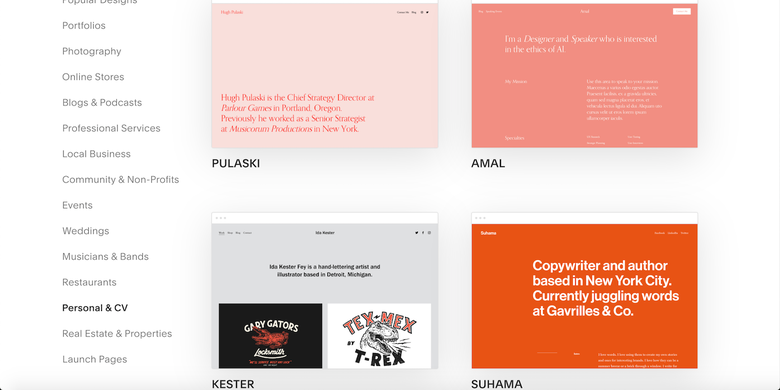
You did it! You graduated. The next step? Getting your first post-college job or internship.
If you haven’t spent much time job hunting, the process can sometimes feel a bit like assembling a puzzle when you don’t know what the finished product is supposed to look like. You know you need to create a resume and a LinkedIn profile, and you should apply to interesting job postings and network as much as possible. But what else can you do to stand out?
Enter the missing piece to your job search puzzle: a personal website. “For new grads, having a professional online presence will serve as an automatic differentiator and establish you as a candidate who’s willing to go the extra mile,” says Kai Heath, founder of Penned by Kai, a boutique writing and branding consultancy. “A personal website will not only enhance your chances of landing a job, but also enable employers and recruiters to find you more easily.”
What is a Personal Website?
A personal website is exactly what it sounds like: a site about you! It’s where entry-level job seekers can showcase things like summer internship or part-time work experience, accomplishments, relevant school projects, and a portfolio. This is your opportunity to expand on what a hiring manager might already know from a resume—and it can fill in the gaps or paint a fuller picture of your skills, abilities, and interests. And because these sites don’t have space limitations, there’s more freedom to express yourself, build a personal brand, and tell your unique story.

“Everyone has a resume. And while they’re super-important, resumes typically only afford you an opportunity to tell your audience what you’ve done and where you’ve done it,” says Christopher Taylor, a job search strategist, former headhunter, and founder of The Occupation Optimist. “Creating a personal website gives you the chance to actually show hiring managers what you’ve done, taking your candidacy for any role to the next level.”
How to Get Started
There are plenty of resources available about how to create a personal website from a more technical standpoint—but the bottom line is you don’t have to be a professional designer to create something impressive. Squarespace makes the process easy, with a tool that helps you pick the right template, which you can customize however you want. This guide walks you through how to incorporate different fonts, images, a color palette, logos, and the like.

The goal of your website is to stand out to hiring managers, so you’ll want your site’s design to support your great content. There’s no one right way to design your personal website—bright colors and eye-catching infographics and fonts might appeal to some, while others may prefer something simple with muted hues. Whichever direction you choose, just keep it work-friendly. “Remember that this is a personal and professional website,” says Heath.
Whatever you do, make sure to keep the navigation straightforward. Depending on how in depth you want to go, you could make a simple one-page website or create separate sections for each topic you cover—say, volunteer experience, personal testimonials, and achievements.
And when you’re done, Taylor advises asking for some honest feedback. “Don’t be afraid to reach out to friends and family with a natural inclination for or professional experience in design for insights,” he says.
Students get 50% off your first website or domain! Details here.
What to Include on a Personal Website
As a recent grad, you might not have a ton of work history to speak of. And that's okay! Relevant experience comes in all shapes and sizes (especially for entry-level job seekers), so don’t be afraid to think outside the box. In addition to the basics—like your name, contact info, headshot, education, and work history (when applicable)—think about incorporating volunteer experience, interesting class projects, testimonials, personal interests, presentations, videos, or a portfolio of your work.

Did your semester abroad inspire you to pursue a career as a translator? Your personal website is the perfect place to share that story. Did you get to help out with a local geological survey through one of your college courses? Include that on your site. Are you passionate about saving the rainforests? Tell your readers why. Overall, focus on connecting a purpose, a passion, or a learning experience to the content of your website in a way that your resume and LinkedIn profile simply don't allow.
As Taylor says, “Displaying activities or expertise that aren't directly related to the type of work you’re looking to pursue will ultimately show that you are a more well-rounded, interesting person.”
How to Get the Word Out
Once you've finished creating your one-of-a-kind site, it's time to share it with the world. Here’s how.
Improve Search Engine Optimization (SEO)
”Just as you would write your resume to include keywords that match job descriptions of interest, you can use the same approach for your site,” says Heath. She recommends incorporating relevant keywords in plain text throughout your website to maximize search engine visibility. Squarespace has a great SEO checklist.
Not sure which keywords will be most relevant to what you’re looking for? Spend some time reading through job postings in your target role or industry, and incorporate the phrases and terms that are most commonly used.

Share It With Your Network
Feature your new website in a LinkedIn post; send an email to your classmates, colleagues, and family members; and text your close friends the link. The more eyeballs you can get on your website the better.
Add Your URL to Everything
“You should have a link to your website wherever you're putting yourself out there,” says Heath. This includes your resume, LinkedIn profile, job-related emails and thank you notes, and in your email signature.
Mention It!
Bring it up at networking events and in informational interviews. “Ask the people you meet with to take a look at your personal website for greater insight into you as a person as well as your qualifications for the role,” Taylor says. “Natural curiosity is going to lead most people to take a peek—and getting seen is half the battle of any application process.”
As a recent graduate, it’s important to find creative ways to differentiate yourself in a competitive job market. You should use every tool at your disposal to make yourself stand out. A compelling personal website allows you to paint a fuller, more vivid picture of who you are and what you bring to the table.